Hugo W.B., Russel A.D.(ed). Pharmaceutical Microbiology
Подождите немного. Документ загружается.

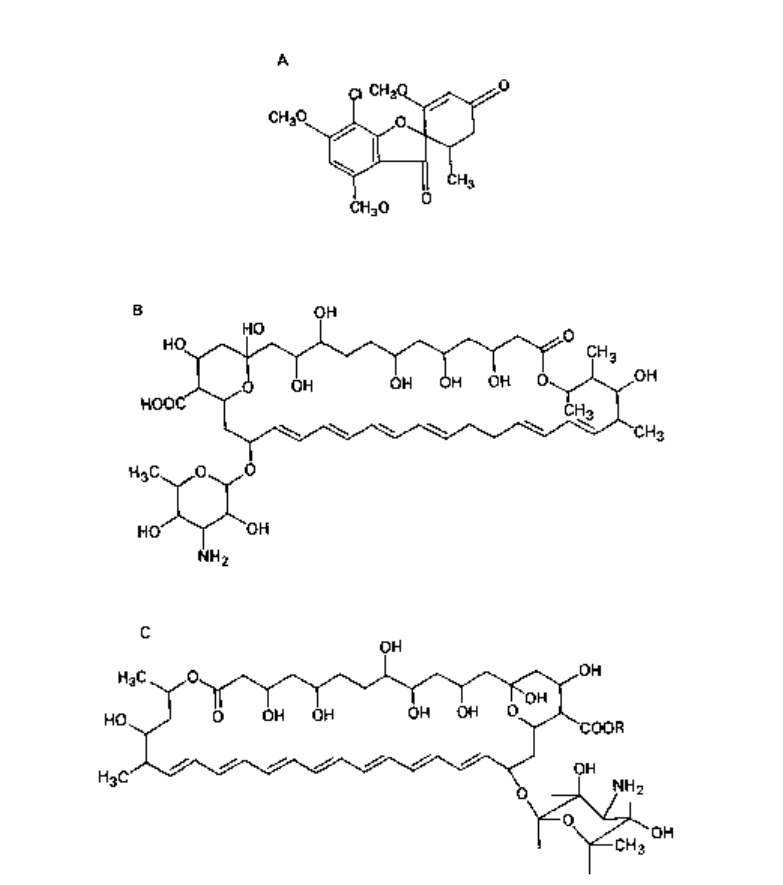
Fig. 5.15 Antifungal antibiotics: A, griseofulvin; B, nystatin; C, amphotericin (R = H) and its
methyl ester (R = CH
3
).
11
11.1
Synthetic antimicrobial agents
Sulphonamides
Sulphonamides were introduced by Domagk in 1935. It had been shown that a red azo
dye, prontosil (Fig. 5.16B), had a curative effect on mice infected with /3-haemolytic
streptococci; it was subsequently found that in vivo, prontosil was converted into
sulphanilamide. Chemical modifications of the nucleus of sulphanilamide (see Fig.
5.16A) gave compounds with higher antibacterial activity, although this was often
accompanied by greater toxicity. In general, it may be stated that the sulphonamides
Types of antibiotics 115
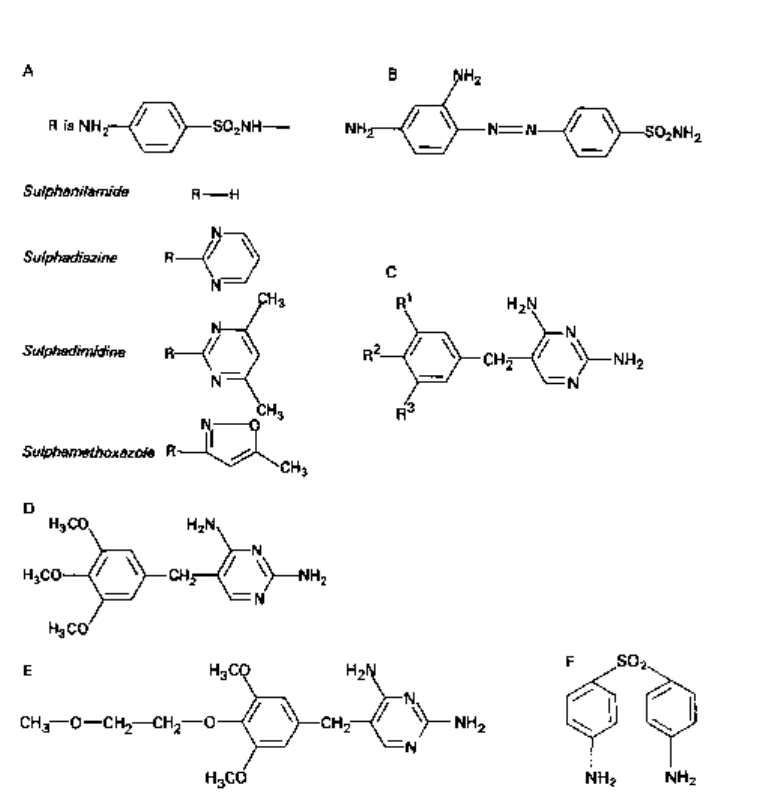
Fig. 5.16 A, some sulphonamides; B, prontosil rubrum; C, unsubstituted diaminobenzylpyrimidines;
D, trimethoprim; E, tetroxoprim; F, dapsone.
have a broadly similar antibacterial activity but differ widely in pharmacological
actions.
Bacteria which are almost always sensitive to the sulphonamides include Strep.
pneumoniae, /3-haemolytic streptococci, Escherichia coli and Proteus mirabilis; those
almost always resistant include Enterococcus faecalis, Ps. aeruginosa, indole-positive
Proteus and Klebsiella; whereas bacteria showing a marked variation in response include
Staph, aureus, gonococci, H. influenzae and hospital strains of E. coli and Pr. mirabilis.
The sulphonamides show a considerable variation in the extent of their absorption
into the bloodstream. Sulphadimidine and sulphadiazine are examples of rapidly
absorbed ones, whereas succinylsulphathiazone and phthalylsulphathiazole are poorly
absorbed and are excreted unchanged in the faeces.
From a clinical point of view, the sulphonamides are extremely useful for the
treatment of uncomplicated urinary tract infection caused by E. coli in domiciliary
practice. They have also been employed in treating meningococcal meningitis (a current
116 Chapter 5
problem is the number of sulphonamide-resistant meningococcal strains) and superficial
eye infections.
11.2 Diaminopyrimidine derivatives
Small-molecule diaminopyrimidine derivatives were shown in 1948 to have an antifolate
action. Subsequently, compounds were developed that were highly active against human
cells (e.g. the use of methotrexate as an anticancer agent), protozoa (e.g. the use of
pyrimethamine in malaria) or bacteria (e.g. trimethoprim: Fig. 5.16D). Unsubstituted
diaminobenzylpyrimidines (Fig. 5.16C) bind poorly to bacterial dihydrofolate reductase
(DHFR). The introduction of one, two or especially three methoxy groups (as in
trimethoprim) produces a highly selective antibacterial agent. A recent antibacterial
addition is tetroxoprim (2,4-diamino-5-(3',5'-dimethoxy-4'-methoxyethoxybenzyl)
pyrimidine; Fig. 5.16E) which retains methoxy groups at R
1
and R
3
and has a
methoxyethoxy group at R
2
. Trimethoprim and tetroxoprim have a broad spectrum of
activity but resistance can arise from a non-susceptible target site, i.e. an altered DHFR
(see Chapter 9).
11.3 Co-trimoxazole
Co-trimoxazole is a mixture of sulphamethoxazole (five parts) and trimethoprim
(one part). The reason for using this combination is based upon the in vitro finding
that there is a 'sequential blockade' of folic acid synthesis, in which the sulphonamide
is a competitive inhibitor of dihydropteroate synthetase and trimethoprim inhibits DHFR
(see Chapter 8, especially Fig. 8.5). The optimum ratio of the two components may not
be achieved in vivo and arguments continue as to the clinical value of co-trimoxazole,
with many advocating the use of trimethoprim alone. Co-trimoxazole is the agent of
choice in treating pneumonias caused by Pneumocystis carinii, a yeast (although it had
been classified as protozoa). Pneumocystis carinii is a common cause of pneumonia in
patients receiving immunosuppressive therapy and in those suffering from AIDS.
11.4 Dapsone
Dapsone (diaminodiphenylsulphone; Fig. 5.16F) is used specifically in the treatment
of leprosy. However, because resistance to dapsone is unfortunately now well known,
it is recommended that dapsone be used in conjunction with rifampicin and clofazimine.
11.5 Antitubercular drugs
The three standard drugs used in the treatment of tuberculosis were streptomycin
(considered above), ^-aminosalicylic acid (PAS) and isoniazid (isonicotinylhydrazide,
INH; synonym, isonicotinic acid hydrazine, INAH). The tubercle bacillus rapidly
becomes resistant to streptomycin, and the role of PAS was mainly that of preventing
this development of resistance. The current approach is to treat tuberculosis in two
phases: an initial phase where a combination of three drugs is used to reduce the bacterial
level as rapidly as possible, and a continuation phase in which a combination of
Types of antibiotics 117
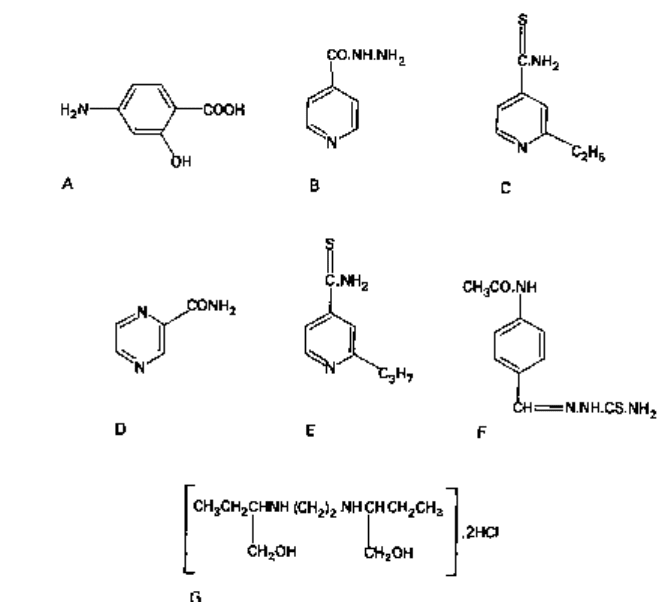
two drags is employed. Front-line drags are isoniazid, rifampicin, streptomycin
and ethambutol. Pyrazinamide, which has good meningeal penetration, and is thus
particularly useful in tubercular meningitis, may be used in the initial phase to produce
a highly bactericidal response.
Isoniazid has no significant effect against organisms other than mycobacteria. It is
given orally. Cross-resistance between it, streptomycin and rifampicin has not been
found to occur.
When bacterial resistance to these primary agents exists or develops, treatment
with the secondary antitubercular drugs has to be considered. The latter group comprises
capreomycin, cycloserine, some of the newer macrolides (azithromycin, clarithromycin),
4-quinolones (e.g. ciprofloxacin, ofloxacin) and prothionamide (no longer marketed in
the UK). Prothionamide, pyrazinamide and ethionamide are, like isoniazid, derivatives
of isonicotinic acid. The British National Formulary no longer lists ethionamide
as being a suitable antitubercular drug. Chemical structures of the above, and of
thiacetazone (not nowadays used because of its side-effects) are presented in Fig. 5.17.
There has, unfortunately, been a global resurgence of tuberculosis in recent years.
Multiple drug-resistant M. tuberculosis (MDRTB) strains have been isolated in which
resistance has been acquired to many drugs used in the treatment of this disease.
Fig. 5.17 Antitubercular compounds (see text also for details of antibiotics): A, PAS; B, isoniazid;
C, ethionamide; D, pyrazinamide; E, prothionamide; F, thiacetazone; G, ethambutol.

11.6
Nitrofuran compounds
The nitrofuran group of drugs (Fig. 5.18) is based on the finding over 40 years ago that
a nitro group in the 5 position of 2-substituted furans endowed these compounds with
antibacterial activity. Many hundreds of such compounds have been synthesized, but
only a few are in current therapeutic use. In the most important nitrofurans, an
azomethine group, —CH=N—, is attached at C-2 and a nitro group at C-5. Less
"important nitrofurans have a vinyl group, —CH=CH—, at C-2.
Biological activity is lost if:
1 the nitro ring is reduced;
2 the —CH=N— linkage undergoes hydrolytic decomposition; or
3 the —CH=CH— linkage is oxidized.
The nitrofurans show antibacterial activity against a wide spectrum of micro-
organisms, but furaltadone has now been withdrawn from use because of its toxicity.
Furazolidone has a very high activity against most members of the Enterobacteriaceae,
and has been used in the treatment of diarrhoea and gastrointestinal disturbances of
bacterial origin. Nitrofurantoin is used in the treatment of urinary tract infections; anti-
bacterial levels are not reached in the blood and the drug is concentrated in the urine. It
is most active at acid pH. Nitrofurazone is used mainly as a topical agent in the treatment
of burns and wounds and also in certain types of ear infections. The nitrofurans are
believed to be mutagenic.
Fig. 5.18 A, furan; B, 5-nitrofurfural; C-F, nitrofuran drugs: respectively C, nitrofurazone, D,
nitrofurantoin, E, furazolidone and F, furaltadone.
Types of antibiotics 119
11.7
4-quinolone antibacterials
Over 10000 quinolone antibacterial agents have now been synthesized. Nalidixic
acid is regarded as the progenitor of the new quinolones. It has been used for
several years as a clinically important drug in the treatment of urinary tract infections.
Since its clinical introduction, other 4-quinolone antibacterials have been synthesized,
some of which show considerably greater antibacterial potency. Furthermore, this
means that many types of bacteria not susceptible to nalidixic acid therapy may be
sensitive to the newer derivatives. The most important development was the introduction
of a fluorine substituent at C-6, which led to a considerable increase in potency and
spectrum of activity compared with nalidixic acid. These second-generation quinolones
are known as fluoroquinolones, examples of which are ciprofloxacin and norfloxacin
(Fig. 5.19).
Nalidixic acid is unusual in that it is active against several different types of Gram-
negative bacteria, whereas Gram-positive organisms are resistant. However, the newer
fluoroquinolone derivatives show superior activity against Enterobacteriacease and
Ps. aeruginosa, and their spectrum also includes staphylococci but not streptococci.
Extensive studies with norfloxacin have demonstrated that its broad spectrum, high
urine concentration and oral administration make it a useful drug in the treatment of
urinary infections. Ciprofloxacin may be used in the treatment of organisms resistant
to other antibiotics; it can also be used in conjunction with a /3-lactam or aminoglycoside
antibiotic, e.g. when severe neutropenia is present.
The third and most recently developed generation of quinolones has maintained many
of the properties of the second generation; examples are lomefloxacin, sparfloxacin (both
difluorinated derivatives) and temafloxacin (a trifluorinated derivative). Lomefloxacin
has a sufficiently long half-life to allow once-daily dosing, but adverse photosensitivity
reactions are now being recognized. Sparfloxacin retains high activity against Gram-
negative bacteria but has enhanced activity against Gram-positive cocci and anaerobes.
Temafloxacin has, unfortunately, been withdrawn from clinical use because of unex-
pected severe haemolytic and nephrotoxic reactions.
11.8 Imidazole derivatives
The imidazoles comprise a large and diverse group of compounds with properties
encompassing antibacterial (metronidazole), antiprotozoal (metronidazole), antifungal
(clotrimazole, miconazole, ketoconazole, econazole) and anti-anthelmintic (mebendazole)
activity: see Table 5.4. Metronidazole (Fig. 5.20A) inhibits the growth of pathogenic
protozoa, very low concentrations being effective against the protozoa Trichomonas
vaginalis, Entamoeba histolytica and Giardia lamblia. It is also used to treat bacterial
vaginosis caused by Gardnerella vaginalis. Given orally, it cures 90-100% of sexually
transmitted urogenital infections caused by T. vaginalis. It has also been found that
metronidazole is effective against anaerobic bacteria, for example B.fragilis, and against
facultative anaerobes grown under anaerobic, but not aerobic, conditions. Metronidazole
is administered orally or in the form of suppositories.
Other imidazole derivatives include clotrimazole (Fig. 5.20B), miconazole (Fig.
5.20C) and econazole (Fig. 5.20D), all of which possess a broad antimycotic spectrum
120 Chapter 5
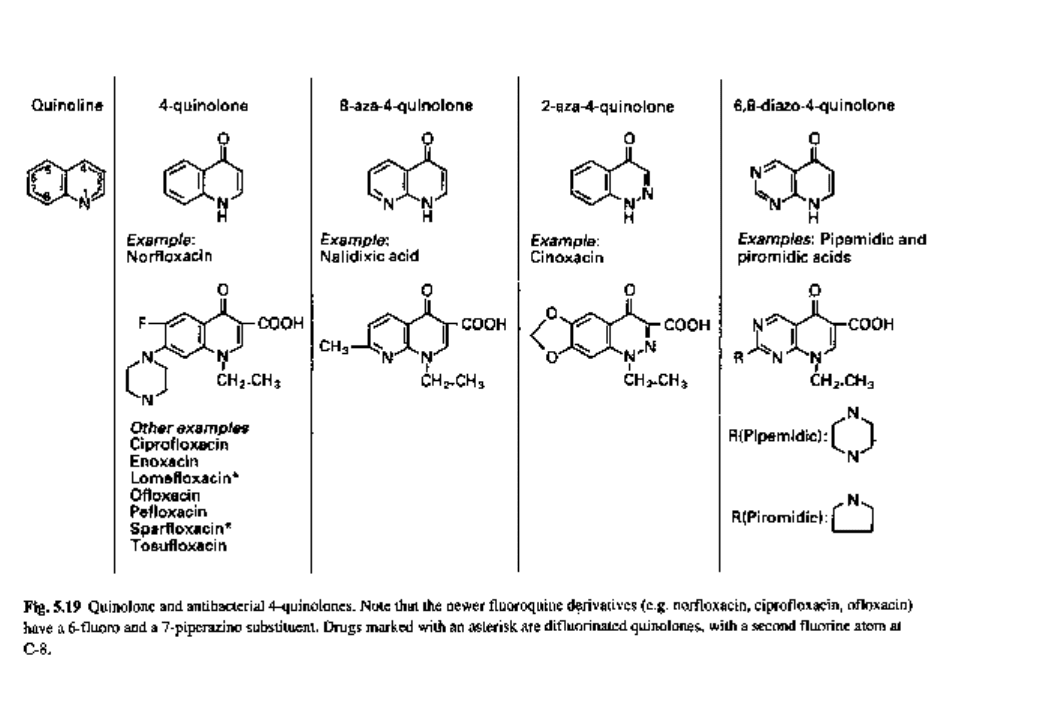
£
Table 5.4 Antimicrobial imidazoles
Antimicrobial
or other activity Examples
Antibacterial Metronidazole, tinidazole: anaerobic bacteria only
Antiprotozoal Metronidazole, tinidazole
Anthelmintic Mebendazole
Antifungal Clotrimazole, miconazole, econazole, ketoconazole
Newer imidazoles: fluconazole, itraconazole
with some antibacterial activity and are used topically. Miconazole is used topically
but can also be administered by intravenous or intrathecal injection in the treatment of
severe systemic or meningeal fungal infections. Newer imidazoles are (a) ketoconazole
(Fig. 5.20E) which is used orally for the treatment of systemic fungal infections (but
not when there is central nervous system involvement or where the infection is life-
threatening), (b) fluconazole (Fig. 5.20F), which is given orally or by intravenous
infusion in the treatment of candidiasis and cryptococcal meningitis. Itraconazole is
well absorbed when given orally after food.
11.9 Flucytosine
Flucytosine (5-fluorocytosine; Fig. 5.20G) is a narrow-spectrum antifungal agent
with greatest activity against yeasts such as Candida, Cryptococcus and Torulopsis.
Evidence has been presented which shows that, once inside the fungal cell, flucytosine
is deaminated ot 5-fluorouracil (Fig. 5.20H). This is converted by the enzyme
pyrophosphorylase to 5-fluorouridine monophosphate (FUMP), diphosphate (FUDP)
and triphosphate (FUTP), which inhibits RNA synthesis; 5-fluorouracil itself has
poor penetration into fungi. Candida albicans is known to convert FUMP to 5-
fluorodeoxyuridine monophosphate (FdUMP), which inhibits DNA synthesis by virtue
of its effect on thymidylate synthetase. Resistance can occur in vivo by reduced uptake
into fungal cells of flucytosine or by decreased accumulation of FUTP and FdUMP.
11.10 Synthetic allylamines
Terbinafine (Fig. 5.171), a member of the allylamine class of antimycotics, is an inhibitor
of the enzyme squalene epoxidase in fungal ergosterol biosynthesis. Terbinafine is
orally active, is fungicidal and is effective against a broad range of dermatophytes and
yeasts. It can also be used topically as a cream.
11.11 Synthetic thiocarbamates
The synthetic thiocarbamates, of which tolnaftate (Fig. 5.20J) is an example, also inhibit
squalene epoxidase. Tolnaftate inhibits this enzyme from C. albicans, but is inactive
against whole cells, presumably because of its inability to penetrate the cell wall.
Tolnaftate is used topically in the treatment or prophylaxis of tinea.
122 Chapter 5
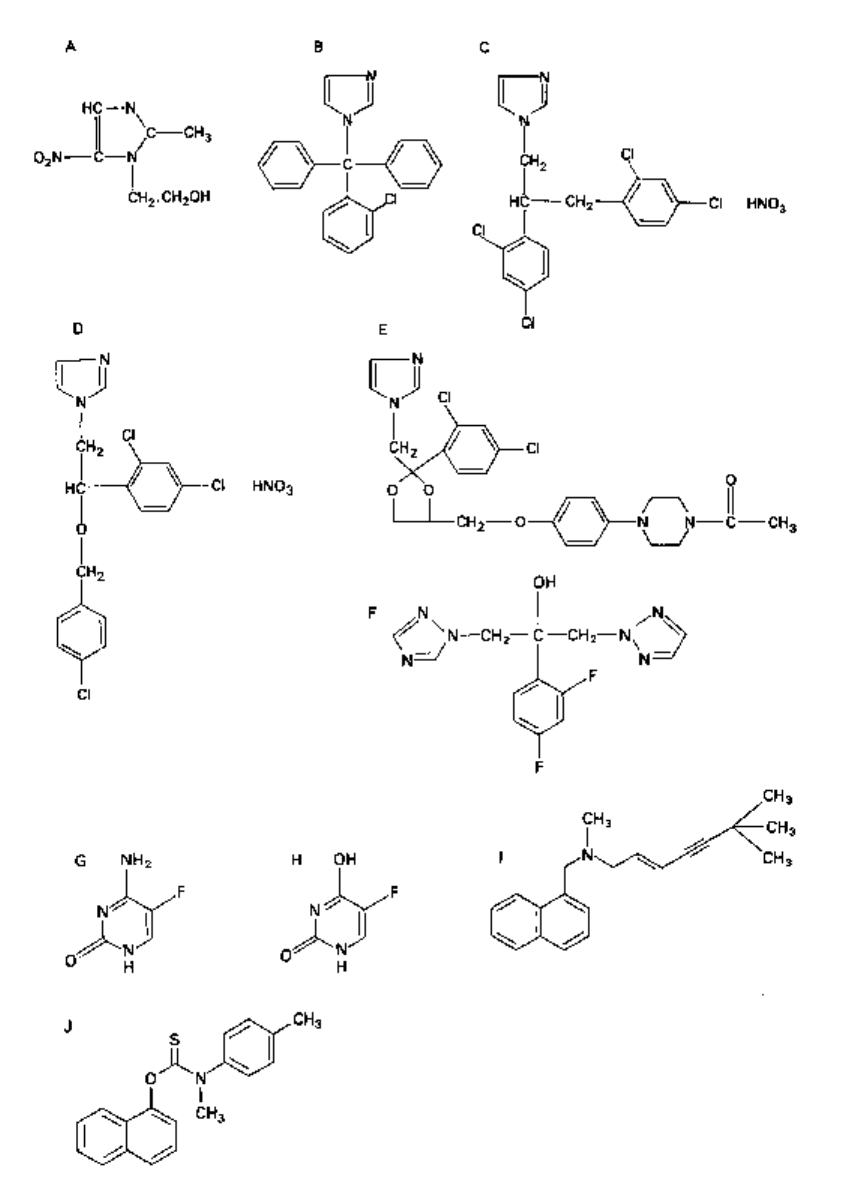
Fig. 5.20 Imidazoles (A-F): A, metronidazole; B, clotrimazole; C, miconazole; D, econazole;
E, ketoconazole; F, fluconazole; G, flucytosine; H, 5-fluorouracil; I, terbinafine; J, tolnaftate.
Types of antibiotics 123

12 Antiviral drugs
Several compounds are known that are inhibitory to mammalian viruses in tissue
culture, but only a few can be used in the treatment of human viral infections. The main
problem in designing and developing antiviral agents is the lack of selective toxicity
that is normally possessed by most compounds. Viruses literally 'take over' the
machinery of an infected human cell and thus an antiviral drug must be remarkably
selectively toxic if it is to inhibit the viral particle without adversely affecting the human
cell. Consequently, in comparison with antibacterial agents, very few inhibitors can be
considered as being safe antiviral drugs, although the situation is improving. Possible
sites of attack by antiviral agents include prevention of adsorption of a viral particle to
the host cell, prevention of the intracellular penetration of the adsorbed virus, and
inhibition of protein or nucleic synthesis.
Genetic information for viral reproduction resides in its nucleic acid (DNA or RNA:
see Chapter 3). The viral particle (virion) does not possess enzymes necessary for its
own replication; after entry into the host cell, the virus uses the enzymes already present
or induces the formation of new ones. Viruses replicate by synthesis of their separate
components followed by assembly.
Antiviral drugs are considered below with a summary in Table 5.5.
12.1 Amantadines
Amantadine hydrochloride (Fig. 5.21A) does not prevent adsorption but inhibits
viral penetration. It has a very narrow spectrum and is used prophylactically against
infection with influenza A virus; it has no prophylactic value with other types of influenza
virus.
Table 5.5 Antiviral drugs and their clinical uses
4
Group
Nucleoside
analogues
Non-nucleoside
analogues
Antiviral
drug
Idoxuridine
Ribavirin (tribavirin)
Zidovudine
Didanosine (DDI)
Zalcitabine (DDC)
Acyclovir (aciclovir)
Famciclovir
Ganciclovir
Fascornet
Amantadines
Clinical uses
Skin including herpes labialis
Severe respiratory syncytial virus
bronchiolitis in infants and
children
AIDS treatment
AIDS treatment
AIDS treatment
r Herpes simplex and varicella zoster
Cytomegalovirus infections in
immunocompromised patients only
Cytomegalovirus retinitis in patients
with AIDS
Prophylaxis: influenza A outbreak
For further information, see the current issue of the British National Formulary.
124 Chapter 5
